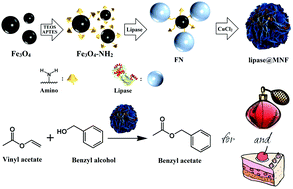Synthesis of magnetic nanoflower immobilized lipase and its continuous catalytic application†
Abstract
The enzyme–inorganic hybrid nanoflowers have attracted wide attention due to their high surface area, enhanced enzymatic activity, and excellent stability for enzyme immobilization. However, difficulties of separation limit their application in the field of food processing. In this work, novel magnetic lipase–Cu3(PO4)2 nanoflowers (lipase@MNFs) were successfully synthesized by the coprecipitation method. The lipase@MNFs are composed of a flower-like copper phosphate skeleton and magnetic ferroferric oxide core with lipase as the coupling agent. The magnetic nanoflowers can be separated quickly from the reaction system under an external magnetic field. Compared with free lipase (∼84.00 U g−1), the lipase@MNFs exhibited higher enzymatic activity (92.63 U g−1, at 37 °C and pH 7.4) and better thermal and pH stability (at 60 °C and pH 10.0). In addition, the magnetic nanoflowers have been applied in the solvent-free biosynthesis of benzyl acetate through benzyl alcohol and vinyl acetate. These results suggest that the design of magnetic nanoflowers opens up a new way to improve the catalytic activity and stability of lipase, and simplify the enzyme separation. The magnetic nanoflowers have potential applications in various enzymatic industrial processes.



 Please wait while we load your content...
Please wait while we load your content...